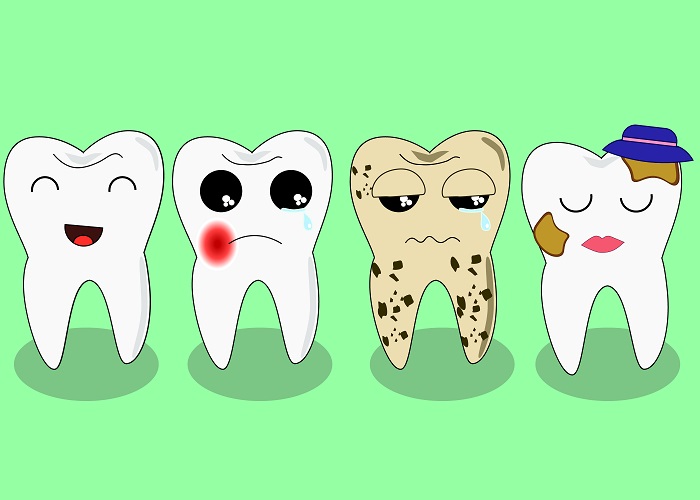
Dental Procedures
- Dental Radiographs - A Diagnostic Tool
- Getting to the root of endodontic (root canal) treatments
- Missing a tooth?
- Root Canal Therapy
- Digital Photography
Share This Page
J FOR THE DENTAL PAT I E N T . . .
A single-tooth implant may be for you
Copyright ©2004 American Dental Association. All rights reserved.
ADA, Vol. 135, October 2004 1499
There are plenty of reasons to replace a missing tooth. A gap between your teeth, if obvious when you smile or speak, is a cosmetic concern.
Depending on their location, some missing teeth may affect your speech. A missing molar might not be noticeable when you talk or smile, but its absence can affect chewing.
When a tooth is missing, the biting force on the remaining teeth begins to change. As the bite changes to compensate for the lost tooth, there is a risk of extra pressure on and discomfort in the jaw joints. If a missing tooth is not replaced, the surrounding teeth can shift. Harmful plaque and tartar can collect in new hard-to-reach places created by the shifting teeth. Over time, this may lead to tooth decay and periodontal disease.
WHAT IS A DENTAL IMPLANT?
A dental implant is one option for replacing a tooth. Implants are manufactured devices that are placed surgically in the upper or lower jaw, where they function as anchors for replacement teeth. Implants are made of titanium and other materials that are compatible with the human body.
An implant looks and feels like a natural tooth. It fits securely when you chew and speak. A single-tooth implant is a free-standing unit and does not involve treatment to the adjacent teeth.
With a dental implant, the surrounding teeth can remain untouched if they are healthy, and their strength and integrity may be maintained. The implant can stabilize your bite and help prevent problems with the jaw.
WHAT HAPPENS DURING THE IMPLANT PROCESS?
Treatment generally is a three-part process that takes several months. Your dentist may provide the treatment, or you may be referred to a specialist— such as a periodontist, a prosthodontist or an oral and maxillofacial surgeon—for all or part of the treatment.
In the first step, the dentist surgically places the implant in the jaw, with the top of the implant slightly above the top of the bone. A screw is inserted into the implant to prevent gum tissue and other debris from entering.
The gum then is secured over the implant, where it will remain covered for approximately three to six months while the implant fuses with the bone, a process called “osseointegration.”
There may be some swelling and/or tenderness for a few days after the surgery, so pain medication usually is prescribed to alleviate the discomfort. A diet of soft foods, cold foods and warm soup often is recommended during the healing process.
In the second step, the implant is uncovered and the dentist attaches an extension, called a “post,” to the implant. The gum tissue is allowed to heal around the post. Once healing is complete, the implant and post will serve as the foundation for the new tooth.
In the final step, the dentist makes a custom artificial tooth, called a “dental crown,” of a size, shape, color and fit that will blend with the other teeth. Once completed, the crown is attached to the implant post.
AM I A CANDIDATE FOR IMPLANTS?
If you are missing a tooth but you are in good general health, with healthy gums and a jawbone that can support an implant, implant treatment may be an option for you. (However, keep in mind that in many cases, third molars—called “wisdom teeth”—do not require replacement.) Health is more a factor than is your age. For example, chronic illnesses, such as diabetes or leukemia, may interfere with healing after surgery. And if you use tobacco, you are at greater risk of experiencing gum disease, which can weaken the bone and tissues needed to support the implant. For more information, visit “www.ada.org/public/ topics/implants.asp”.
Prepared by the ADA Division of Communications, in cooperation with The Journal of the American Dental Association. Unlike other portions of JADA, this page may be clipped and copied as a handout for patients, without first obtaining reprint permission from the ADA Publishing Division. Any other use, copying or distribution, whether in printed or electronic form, is strictly prohibited without prior written consent of the ADA Publishing Division.
“For the Dental Patient” provides general information on dental treatments to dental patients. It is designed to prompt discussion between dentist and patient about treatment options and does not substitute for the dentist’s professional assessment based on the individual patient’s needs and desires.
A single-tooth implant may be for you
Copyright ©2004 American Dental Association. All rights reserved.
ADA, Vol. 135, October 2004 1499
There are plenty of reasons to replace a missing tooth. A gap between your teeth, if obvious when you smile or speak, is a cosmetic concern.
Depending on their location, some missing teeth may affect your speech. A missing molar might not be noticeable when you talk or smile, but its absence can affect chewing.
When a tooth is missing, the biting force on the remaining teeth begins to change. As the bite changes to compensate for the lost tooth, there is a risk of extra pressure on and discomfort in the jaw joints. If a missing tooth is not replaced, the surrounding teeth can shift. Harmful plaque and tartar can collect in new hard-to-reach places created by the shifting teeth. Over time, this may lead to tooth decay and periodontal disease.
WHAT IS A DENTAL IMPLANT?
A dental implant is one option for replacing a tooth. Implants are manufactured devices that are placed surgically in the upper or lower jaw, where they function as anchors for replacement teeth. Implants are made of titanium and other materials that are compatible with the human body.
An implant looks and feels like a natural tooth. It fits securely when you chew and speak. A single-tooth implant is a free-standing unit and does not involve treatment to the adjacent teeth.
With a dental implant, the surrounding teeth can remain untouched if they are healthy, and their strength and integrity may be maintained. The implant can stabilize your bite and help prevent problems with the jaw.
WHAT HAPPENS DURING THE IMPLANT PROCESS?
Treatment generally is a three-part process that takes several months. Your dentist may provide the treatment, or you may be referred to a specialist— such as a periodontist, a prosthodontist or an oral and maxillofacial surgeon—for all or part of the treatment.
In the first step, the dentist surgically places the implant in the jaw, with the top of the implant slightly above the top of the bone. A screw is inserted into the implant to prevent gum tissue and other debris from entering.
The gum then is secured over the implant, where it will remain covered for approximately three to six months while the implant fuses with the bone, a process called “osseointegration.”
There may be some swelling and/or tenderness for a few days after the surgery, so pain medication usually is prescribed to alleviate the discomfort. A diet of soft foods, cold foods and warm soup often is recommended during the healing process.
In the second step, the implant is uncovered and the dentist attaches an extension, called a “post,” to the implant. The gum tissue is allowed to heal around the post. Once healing is complete, the implant and post will serve as the foundation for the new tooth.
In the final step, the dentist makes a custom artificial tooth, called a “dental crown,” of a size, shape, color and fit that will blend with the other teeth. Once completed, the crown is attached to the implant post.
AM I A CANDIDATE FOR IMPLANTS?
If you are missing a tooth but you are in good general health, with healthy gums and a jawbone that can support an implant, implant treatment may be an option for you. (However, keep in mind that in many cases, third molars—called “wisdom teeth”—do not require replacement.) Health is more a factor than is your age. For example, chronic illnesses, such as diabetes or leukemia, may interfere with healing after surgery. And if you use tobacco, you are at greater risk of experiencing gum disease, which can weaken the bone and tissues needed to support the implant. For more information, visit “www.ada.org/public/ topics/implants.asp”.
Prepared by the ADA Division of Communications, in cooperation with The Journal of the American Dental Association. Unlike other portions of JADA, this page may be clipped and copied as a handout for patients, without first obtaining reprint permission from the ADA Publishing Division. Any other use, copying or distribution, whether in printed or electronic form, is strictly prohibited without prior written consent of the ADA Publishing Division.
“For the Dental Patient” provides general information on dental treatments to dental patients. It is designed to prompt discussion between dentist and patient about treatment options and does not substitute for the dentist’s professional assessment based on the individual patient’s needs and desires.


